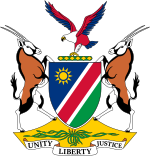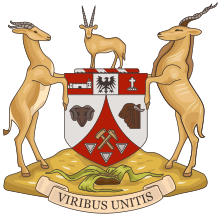Coat of arms of Namibia
| Coat of arms of Namibia | |
|---|---|

|
|
| Details | |
| Introduced | March 21, 1990 |
| Heraldic shield | Flag of Namibia |
| Sign holder | Oryx antelopes |
| Motto (motto) | Unity, freedom, justice |
The coat of arms of Namibia was adopted on March 21, 1990 for the independence of the country.
description
The coat of arms is divided into blue and green by a right, red, white-lined sloping bar. In the front field is a golden sun . Two naturalistic billy goats hold the coat of arms standing on desert sand as a shield holder . A green Welwitschia in the desert sand . Above the sign on a green and gold toque a fish eagle in the national colors. Under the coat of arms the motto
- " Unity, Liberty, Justice "
- ( Unity, freedom, justice )
symbolism
The individual elements of the coat of arms have the following meaning: The coat of arms shield contains the flag of Namibia and also has the same symbolism (see here ). He stands firmly in the sand of the millennia-old Namib desert .
Welwitschia mirabilis , one of the oldest plants in the world, is rooted in this sand .
The fish eagle represents the north of Namibia and its water resources . The fish eagle is known for its piercing scream and powerful appearance. It is supposed to represent the future of Namibia.
The two billy goats on each side of the shield are typical of the semi- arid regions of Namibia. They symbolize elegance , pride and courage .
The coat of arms bears the English motto of the state, which names the basic principles of the constitution of the Republic of Namibia:
- " Unity, Liberty, Justice "
- ( Unity, freedom, justice )
history


In 1913, the German Colonial Office designed a coat of arms for the German South West Africa protected area , which showed a black eagle with a black and silver breastplate in the golden shield head. Below that was a silver ox head in blue, with a diamond between its horns. The German imperial crown hovered over the shield.
This coat of arms was placed on the flag of the German Empire in a slightly different form .
Parts of this design were also found in the coat of arms created in 1961 for South West Africa administered by the Republic of South Africa .
See also
literature
- Karl-Heinz Hesmer: Flags and coats of arms of the world. History and symbolism of the flags and coats of arms of all states. Bertelsmann Lexikon Verlag, Gütersloh 1992, ISBN 3-570-01082-1 .
Web links
- Flag lexicon (description of flag and coat of arms)